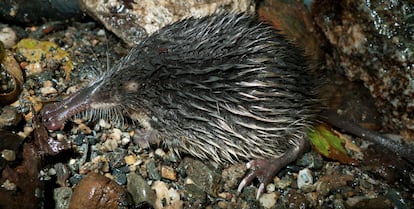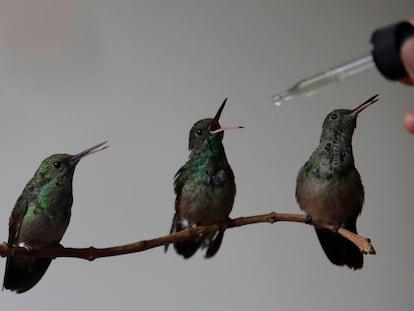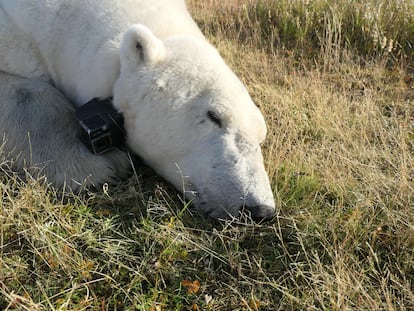A rare mammal with a trunk-like snout and webbed feet: The Iberian desman faces extinction
The ‘Spanish platypus’ is unique to the Iberian Peninsula and a jewel of evolution that has lost up to 70% of the geographical range it occupied three decades ago


It is small, chubby, rat-like, an exceptional diver, with a snout in the shape of a trunk, nocturnal, and one of the great forgotten mammals of Spain’s natural world. The Iberian desman (Galemys pyrenaicus), like the Iberian lynx or the Cantabrian brown bear, lives exclusively in the Iberian Peninsula and is endangered but does not attract as many resources for its conservation, despite losing 70% of its geographic distribution since 1990. Its decline appears to be unstoppable. If it were lost, a jewel of evolution would disappear — there is only one other in the world, the Russian desman. The species needs clean, oxygenated water, unfragmented habitats in fast-flowing rivers that maintain the flow in summer, in the absence of large dams, and intact riverbanks where it can take refuge. These requirements are difficult to meet at present, and are being aggravated by increasingly frequent droughts due to climate change. The latest diagnosis by Spain’s Ministry for Ecological Transition, carried out this year, is so pessimistic that predictive models indicate the desman could become extinct in the short term — between 10 and 30 years — if immediate action is not taken.
Ángel Fernández González, a biologist, environmental consultant, and one of Spain’s leading experts on the species, remembers when the desman lived in more buoyant times and his grandfather told him: “I don’t understand how you can make a living with that rat.” He enjoyed fishing and knew the desmans that lived in the natural park of Somiedo (Asturias), when he used to catch trout with a fixed rod, an ancient technique that forces fishermen to remain still for a long time, facilitating his encounters with the elusive creatures. Back then, the micromammal was abundant there, but now it has been relegated to a couple of headwater rivers. “The trend is negative in all the places in Spain where it survives,” says González, who is preparing an update of the conservation status commissioned by the ministry.
Faced with the disastrous data, on March 11 the ministry convened a working group on the species, formed by Spain’s autonomous regions and the state, to which experts were also invited. “There was unanimity that the situation requires an immediate reaction,” explains Ricardo Gómez, head of the ministry’s Wildlife Service and of the sub-directorate general of Terrestrial and Marine Biodiversity. Among the measures considered essential is the fight against the American mink — an invasive species and one of the desman’s main predators — cataloging the entire desman population in critical danger of extinction, because currently only those concentrated in the Central System mountain range are considered as such while the remainder have a lower degree of protection. Other plans are also being considered, such as captive breeding, something that has not yet been achieved.
Crumbs in very small nuclei
“It is our platypus; it appears to be made of pieces of other animals and it is leaving us at a staggering speed,” says Jorge González Esteban, a biologist and environmental consultant who also works on the project and who participated in the first inventory of the species in the early 1990s. At that time there was already a decline, but “it was unthinkable that we would reach a point like the present,” because the desman distribution was still wide.
Nor did it cross Félix Rodríguez de la Fuente’s mind when he recorded the “incredible Pyrenean desman,” which had never been filmed in the wild, for an episode of the emblematic 1970s Spanish television series El Hombre y la Tierra (Man and Earth). The famous naturalist described it as “a strange water mole, which captures aquatic insect larvae” and needs “crystal clear water.” The current change is so drastic that “before, the distribution area could be represented as a whole loaf of bread, with a continuous population. Now we only have crumbs distributed in very small nuclei,” explains González Esteban.
These crumbs are distributed across five sites in Spain, Portugal, France, and Andorra. The western one extends through the north of Portugal, Galicia, and the western part of Asturias, León, and Zamora; the Cantabrian one through the eastern part of Asturias, León, Cantabria, and Palencia; the Pyrenean one through both sides of the Pyrenees; the Iberian System through La Rioja, Burgos, and Soria, and the Central System — one of the most endangered — through Ávila and Cáceres. The northwestern populations are in the best condition, because the rivers are still relatively connected.
Jose Castresana, a researcher at the Spanish Institute of Evolutionary Biology, points out that there is “very little knowledge about the species, which is very unique from an evolutionary point of view.” Only two types of desmans exist, the Iberian and the Russian. “It is an evolutionary jewel and is a great responsibility for the countries where it lives,” he adds.
Through genetic analysis, Castresana found that “the outlook is much worse than expected.” The desman, he explains, has one of the lowest genetic diversities of all mammals, “more so than the lynx or the European mink,” which makes them less resistant to environmental changes or diseases. “This characteristic has to do with the evolution of the species. It has not been generated now; it probably dates from the ice ages, when there must have been few specimens left,” he explains.
To this must be added inbreeding, “a factor that is a product of the alteration that their habitat has suffered, which prevents the populations from connecting with each other due to barriers, so that the ungulates in the upper stretches of the rivers have no relatives in the lower parts,” Castresana says. Through analysis of the animal’s hair DNA researchers have found that there are high levels of inbreeding because the animals have been mating for decades between very close relatives. “It is a very sad situation and a problem that was suspected, but without reaching the magnitude we have witnessed,” Castresana explains. He does not know if this high rate of inbreeding plays a fundamental role in the disappearance of the species, “but it is not a flattering fact, because it can affect fertility and lead to extinction.”
Is there still time to save the species? “If we haven’t implemented the main actions in four years, we’ll be left with no desman,” says Ramón Pérez de Ayala, a member of the conservationist NGO WWF, which is supporting the recovery project. “The outlook is worse than when I started working with the lynx; we don’t even know how many specimens there are,” he notes. Despite the difficult situation, experts agree that we are on the right track and there is a consensus among administrations to implement urgent measures. The International Union for the Conservation of Nature has also been active and is organizing a transnational strategy among the four countries where the Iberian desman lives to address its conservation. However, “the prospects would be better if we had started in 1990; now is the time for desperate measures,” says González Esteban.
Sign up for our weekly newsletter to get more English-language news coverage from EL PAÍS USA Edition









































